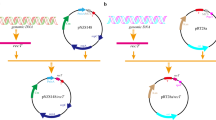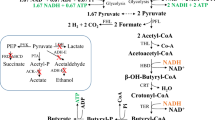Abstract
Hybrids between Escherichia coli and Lactobacillus brevis were generated via protoplast fusion. Growth kinetics of five hybrid strains and E. coli were used to evaluate the butanol tolerance of the novel strains under different conditions. The hybrid strains tolerated up to 2% (v/v) butanol compared to the 1% (v/v) maximum for E. coli. The growth inhibitory effects of butanol were also significantly less in several of the hybrids compared to E. coli. These results demonstrate the potential use of protoplast fusion to generate butanol-tolerant strains.
Similar content being viewed by others
Introduction
Butanol toxicity is one of the challenges currently facing the microbial production of biobutanol. Even the native producer, Clostridium acetobutylicum, only tolerates up to 1–2% (v/v) of this organic solvent. Butanol tolerance is a complex phenotype, involving multiple loci (Papoutsakis 2008; Klein-Marcuschamer et al. 2009), rendering the engineering of strains for enhanced resistance to this solvent difficult. Thus far, efforts for enhancing butanol tolerance have mainly focused on the enrichment of mutants via serial transfers (Lin and Blaschek 1983; Soucaille et al. 1987). More recently, mutagenesis of the RNA polymerase in E. coli resulted in a mutant with enhanced resistance to butanol toxicity from 80% inhibition to 50% inhibition in 0.9% (v/v) butanol (Klein-Marcuschamer et al. 2009). These efforts have relied on modifications of existing machinery in the native organisms, which may yield limited success. A recent report surveyed a wide range of microorganisms for their inherent tolerance to butanol; most organisms analyzed exhibited significant growth inhibition in 1–2% (v/v) of butanol with the exception of Lactobacillus brevis, which was able to sustain growth in 3% (v/v) butanol (Knoshaug and Zhang 2009).
Lactobacillus brevis, a Gram-positive bacterium, may be a promising candidate to be engineered as a biobutanol producer due to its higher inherent tolerance to the product. However, L. brevis lacks many biosynthetic genes and has high nutritional requirements (Makarova et al. 2006). In addition, it is not a widely studied organism and the molecular mechanisms involved in the higher butanol tolerance in L. brevis are unknown. On the other hand, Escherichia coli, one of the most well-studied organisms, is a non-fastidious organism with relatively low nutritional requirements. Recent efforts have successfully metabolically engineered E. coli, a non-native producer, to produce butanol (Atsumi et al. 2008; Inui et al. 2008). However, E. coli has low tolerance to butanol (up to 1% v/v). The ability to generate strains that contain the benefits of both organisms can potentially be useful for engineering biobutanol producers. Protoplast fusion and genome shuffling have been demonstrated as a useful tool for generating strains with novel properties (Patnaik et al. 2002; John et al. 2008). We have successfully fused the genomes of E. coli and L. brevis to isolate hybrids with enhanced resistance to butanol compared to E. coli and lower nutritional requirements than L. brevis.
Materials and methods
Bacterial strains and media
Escherichia coli BW25113 and Lactobacillus brevis ATCC 367 were used. E. coli was grown on LB media at 37°C and L. brevis was grown on MRS (BD) media at 30°C. The hybrids were grown on LB media unless noted otherwise.
Protoplast fusion
Cultures of both E. coli and L. brevis were grown to an OD600 of between 0.7 and 1 from a 2% (v/v) inoculum of overnight cultures. Protoplasts of E. coli were generated using the protocol previously described on LB soft agar with 0.5 M sucrose (Dai et al. 2005). The protoplasts of L. brevis were generated using a modified protocol from Cocconcelli et al. (1986). Briefly, the L. brevis cells were collected by centrifugation, washed once with 0.01 M Tris/HCl pH 8.0, washed twice with SMM buffer (0.5 M sucrose, 20 mM sodium maleate monohydrate, 20 mM MgCl2, pH 7.1), and the cell wall was digested with 2 mg lysozyme/ml and 30 μg mutanolysin (Sigma)/ml at 30°C for 20 min. A small portion of the digested cells were serially diluted in either sterile water and plated on MRS plates for estimation of protoplast formation efficiencies or in SMM buffer and plated on regeneration medium (RM; MRS, 1.5% agar, 0.5 M sucrose, 20 mM MgCl2, 2.5% gelatin, 0.5% heat inactivated bovine serum albumin) plates for estimation of protoplast regeneration efficiencies. The resulting protoplasts of E. coli and L. brevis were mixed together and DNA from lysed cells was digested with DNase I (Promega) at room temperature for 10 min. The protoplasts were incubated at room temperature for 10 min and centrifuged at 2000×g and 4°C for 20 min. After centrifugation, the protoplasts were resuspended in PEG buffer (SMM + 0.4 g/ml PEG 6000, 5% v/v DMSO, 10 mM CaCl2) and incubated at room temperature for 6 min. The protoplasts were centrifuged again at 2000×g and 4°C for 20 min, and then resuspended in SMM buffer, plated on RM plate at various dilutions, and incubated at 30°C for 3 days.
Measurements of growth kinetics
Cultures were grown overnight in either LB or M9 minimum media supplemented with 0.5% glucose at either 30 or 37°C. Growth kinetic measurements for each strain in varying concentrations of 1-butanol were taken in 96 well plates with the Infinite M200 plate reader (TECAN) with shaking and incubating capabilities. The total volume of the culture in each well was 100 μl. Each replicate measurements for each strain and condition were measured in different wells within the 96 well plate to ensure that potential difference in O2 transfer rates do not bias the differences in the growth kinetic measurements for the different strains. OD measurements were taken every 640 s. The resulting growth kinetic data were plotted on semi-log plots and the logarithmic growth regions were identified. The growth kinetic parameters of the specific growth rate (μ) and maximum cell density achieved were calculated for each strain in each condition.
16S rDNA determination
The genomic DNA of all hybrids were purified using the DNeasy kit (Qiagen). The presence of 16S rDNA sequences for E. coli and L. brevis were determined via PCR with the purified genomic DNA using the following primer pairs: for the E. coli 16S rDNA (BW25113_16S_for: 5′-GCTTGCTTCTTTGCTGACGAGTG-3′ and BW25113_16S_rev: 5′-TACGCATTTCACCGCTACACC-3′) and for the L. brevis 16S rDNA (ATCC367_16S_for: 5′-TGAAAGGTGGCTTCGGCTATC-3′ and ATCC367_16S_rev: 5′-GCGGAAACCCTCCAACACTTAG-3′).
Results and discussion
Generation of hybrids between E. coli and L. brevis
Protoplast fusions between two different species were first reported by Gokhale et al. (1984). Since then, the generation of interspecific protoplast fusions has been successfully used to combine desirable properties from different organisms (Chen et al. 1987; Wei et al. 2001; John et al. 2008). The resulting interspecific hybrids are reported to be stably maintained (Chen et al. 1987; Wei et al. 2001), and thus are likely to be haploid recombinants. No interspecific hybrids between E. coli and Lactobacillus have been previously reported. Here we report the generation of hybrids between E. coli and L. brevis using protoplast fusion techniques. The resulting efficiencies for protoplast formation and regeneration for both organisms are shown in Table 1. For the identification of true fusion products, we first characterized differential permissive growth conditions for E. coli and L. brevis by growing each strain on different solid media (LB, MRS, RM, and M9 minimum medium). The results are shown in Table 2. As expected, L. brevis has higher nutritional requirements compared to E. coli and is not able to grow on LB or M9 minimum medium. On the other hand, E. coli was not able to grow on either MRS or RM, most likely due to the 5 g/l of sodium acetate present in the medium, as acetate disrupts intracellular pH and inhibits growth (Luli and Strohl 1990). Based on the results, the protoplast fusion products selected on regeneration medium were most likely a combination of pure L. brevis and true hybrids. Thus, true hybrids were identified as fusants that are able to grow on both MRS and LB media, since neither E. coli nor L. brevis are able to grow on both. We isolated a total of 70 hybrids and chose 5 (named KKOB2-6) to further characterize.
Characterization of hybrids
The morphologies of the hybrids were examined and related to the original E. coli and L. brevis strains (morphologies are shown in Supplementary Figure 1 and summarized in Table 3). The KKOB2 and KKOB6 strains most similar to that of E. coli, while the KKOB3-5 strains were more similar to that of L. brevis.
The 16S rDNA inheritance of the hybrids were estimated using E. coli and L. brevis specific primers. It appears that all five hybrids had inherited the E. coli 16S rDNA. No products were observed with the L. brevis specific primers in any of the hybrids, possibly suggesting that the hybrid genome is composed of more E. coli than L. brevis sequences.
The level of butanol tolerance in the hybrids
To establish the butanol tolerance of the hybrid strains generated in this study, growth kinetics were evaluated in LB medium with the addition of up to 3% (v/v) butanol for comparison with the tolerance level of native E. coli. These results are shown in Fig. 1. All hybrids grew robustly in LB only media (without butanol), achieving specific growth rates between 69 to 100% and final OD values similar to that of E. coli. Two hybrids (KKOB2 and KKOB6) exhibited the same levels of butanol tolerance as E. coli, while the other three (KKOB3, KKOB4, and KKOB5) exhibited increased resistance to butanol. Though E. coli growth was dramatically inhibited at 1% (v/v) butanol, the growths of the three hybrids were not inhibited at 1% (v/v) butanol at 30°C. At the lower temperature, the hybrids grew in up to 2% (v/v) butanol and achieved a final OD of approx. 66% of that without butanol (data not shown). After growth in LB with 1.5% (v/v) butanol at 30°C, the three most butanol tolerant strains (KKOB3-5) maintained their cell morphology (long rods) and their ability to grow on MRS (data not shown). An increase in temperature can enhance the toxicity of butanol (Knoshaug and Zhang 2009) and this was observed for all tested hybrids. At 37°C, the maximum concentration of butanol permitting growth in all strains was 1% (v/v). However, the hybrids (KKOB3-5) still exhibited higher tolerance at 37°C compared to E. coli at 37°C.
Inhibition of growth by butanol in LB medium at a 30°C and b 37°C. Values and error bars are based on four replicate measurement for each strain at each condition. Reference specific growth rates at 30°C are: 0.52 h−1 (KKOB2), 0.39 h−1 (KKOB3), 0.35 h−1 (KKOB4), 0.36 h−1 (KKOB5), 0.52 h−1 (KKOB6), 0.51 h−1 (BW25113). Reference specific growth rates at 37°C are: 0.52 h−1 (KKOB2), 0.43 h−1 (KKOB3), 0.42 h−1 (KKOB4), 0.40 h−1 (KKOB5), 0.56 h−1 (KKOB6), 0.53 h−1 (BW25113). The specific growth rates for each strain, and the times and optical densities used for the calculations are listed in Supplementary Table 1. Hybrids with growth inhibition levels significantly less than E. coli at each butanol concentration are marked with an asterisk. Statistical significance was computed using the two-tailed student t-test. Note that the growth of KKOB6 at 37°C in 1.5% (v/v) butanol was only observed in three out of the four replicates
Among the five characterized hybrids, only two (KKOB2 and KKOB6) grew robustly in M9 minimum medium. Similar to growth on LB, these hybrids exhibited butanol tolerance close to that of E. coli. The temperature-dependent tolerance to the organic solvent was also observed in M9 minimum medium. At 30°C, the three strains grew in up to 1% (v/v) butanol whereas at 37°C the strains only grew in up to 0.7% (v/v) butanol (data not shown). The growth characteristics of the KKOB2 and KKOB6 strains may suggest that they lack the L. brevis genes that impart the enhanced butanol tolerance seen in the other hybrids.
Interestingly, some samples exhibited growth at a higher concentration of butanol (but not at a lower concentration of butanol) in one out of four replicates. These outlier growths are always accompanied by a long growth lag, suggesting that growth at these higher concentrations originates from adaptive mutations conferring improved butanol tolerance. It is unlikely that these instances were the results of contamination as no such growth was observed in the negative controls (no cell controls) included for all butanol concentrations in every run. In addition, two replicates in each 96 well plate were from the same overnight inoculum. Contamination of the overnight inoculum should therefore result in observed growth in both replicates within the plate, but in this case growth was only observed in a single replicate. The reasons for these outlier growths are under investigation.
This study establishes a system for generating hybrids between E. coli and L. brevis towards the goal of engineering strains with higher butanol tolerance. Further improvements in reducing the nutritional requirements and growth in higher butanol concentrations may be achieved by genome shuffling between the different hybrids and their parents. Since the genomes of both E. coli and L. brevis are both fully sequenced, further genomic analysis of these hybrids may reveal the molecular mechanisms of butanol tolerance in L. brevis.
References
Atsumi S, Cann AF, Connor MR, Shen CR, Smith KM, Brynildsen MP, Chou KJ, Hanai T, Liao JC (2008) Metabolic engineering of Escherichia coli for 1-butanol production. Metab Eng 10:305–311
Chen W, Ohmiya K, Shimizu S (1987) Intergeneric protoplast fusion between Fusobacterium varium and Enterococcus faecium for enhancing dehydrodivanillin degradation. Appl Environ Microb 53:542–548
Cocconcelli PS, Morelli L, Vescovo M, Bottazzi V (1986) Intergeneric protoplast fusion in lactic-acid bacteria. FEMS Microbiol Lett 35:211–214
Dai M, Ziesman S, Ratcliffe T, Gill RT, Copley SD (2005) Visualization of protoplast fusion and quantitation of recombination in fused protoplasts of auxotrophic strains of Escherichia coli. Metab Eng 7:45–52
Gokhale DV, Eun SH, Srinivasan VR, Deobagkar DN (1984) Transfer of DNA coding for cellulases from Cellulomonas species to Bacillus subtilis by protoplast fusion. Biotechnol Lett 6:627–632
Inui M, Suda M, Kimura S, Yasuda K, Suzuki H, Toda H, Yamamoto S, Okino S, Suzuki N, Yukawa H (2008) Expression of Clostridium acetobutylicum butanol synthetic genes in Escherichia coli. Appl Microbiol Biotechnol 77:1305–1316
John RP, Gangadharan D, Nampoothiri KM (2008) Genome shuffling of Lactobacillus delbrueckii mutant and Bacillus amyloliquefaciens through protoplasmic fusion for L-lactic acid production from starchy wastes. Bioresour Technol 99:8008–8015
Klein-Marcuschamer D, Santos CN, Yu H, Stephanopoulos G (2009) Mutagenesis of the bacterial RNA polymerase alpha subunit for improvement of complex phenotypes. Appl Environ Microbiol 75:2705–2711
Knoshaug EP, Zhang M (2009) Butanol tolerance in a selection of microorganisms. Appl Biochem Biotechnol 153:13–20
Lin YL, Blaschek HP (1983) Butanol production by a butanol-tolerant strain of Clostridium acetobutylicum in extruded corn broth. Appl Environ Microbiol 45:966–973
Luli GW, Strohl WR (1990) Comparison of growth, acetate production, and acetate inhibition of Escherichia coli strains in batch and fed-batch fermentations. Appl Environ Microbiol 56:1004–1011
Makarova K et al (2006) Comparative genomics of the lactic acid bacteria. Proc Natl Acad Sci USA 103:15611–15616
Papoutsakis E (2008) Engineering solventogenic Clostridia. Curr Opin Biotechnol 19:420–429
Patnaik R, Louie S, Gavrilovic V, Perry K, Stemmer WPC, Ryan CM, del Cardayre S (2002) Genome shuffling of Lactobacillus for improved acid tolerance. Nat Biotechnol 20:707–712
Soucaille P, Joliff G, Izard A, Goma G (1987) Butanol tolerance and autobacteriocin production by Clostridium acetobutylicum. Curr Microbiol 14:295–299
Wei WL, Wu KL, Qin Y, Xie Z, Zhu XS (2001) Intergeneric protoplast fusion between Kluyveromyces and Saccharomyces cerevisiae—to produce sorbitol from Jerusalem artichokes. Biotechnol Lett 23:799–803
Acknowledgements
We thank Dr. Albert Lee for assistance with experimentation and comments on the manuscript, Maria Priscilla Almario Falla for assistance with experimentation, and the National Science Foundation REU Grant 0552655 (MR) for funding.
Author information
Authors and Affiliations
Corresponding author
Additional information
James Winkler and Matthew Rehmann contributed equally to this work.
Electronic supplementary material
Below is the link to the electronic supplementary material.
Rights and permissions
About this article
Cite this article
Winkler, J., Rehmann, M. & Kao, K.C. Novel Escherichia coli hybrids with enhanced butanol tolerance. Biotechnol Lett 32, 915–920 (2010). https://doi.org/10.1007/s10529-010-0247-3
Received:
Revised:
Accepted:
Published:
Issue Date:
DOI: https://doi.org/10.1007/s10529-010-0247-3





